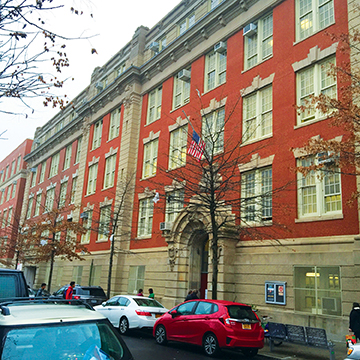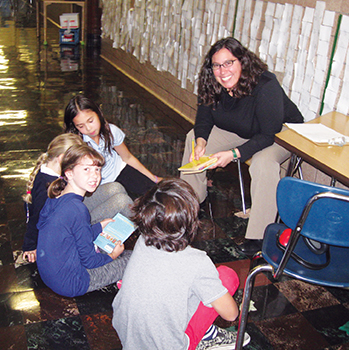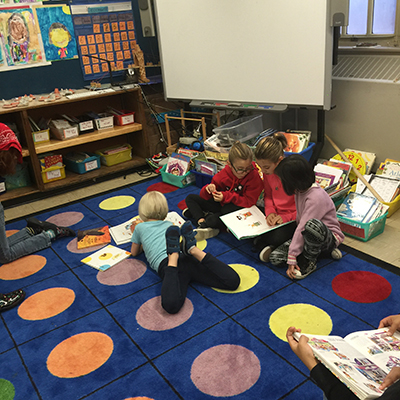I recently had the wonderful opportunity to sit down with Anna Allanbrook, veteran principal of Brooklyn New School (P.S. 146). BNS has been called “a joyful, time-tested school” by Inside Schools, and as Allanbrook led me on a tour of the school and its garden, I had to agree.
In each classroom, students were excitedly learning from hands-on activities—like the third grade science class using flashlights to recreate the changing angle of shadows made by the sun over the course of the day. Students and teachers in this class and others were full of wonder and curiosity. As Allanbrook says, “the classroom door does not close,” and teachers collaborate to ensure all students receive the same creative, “rich” curriculum. Allanbrook studied painting as an undergraduate at Pratt, and she and many others in the school tend to look at education “through an artist’s lens.”

While speaking with Allanbrook—who has been the principal of BNS since 2000, and before that, its co-teacher director since 1997—I was struck by how the school’s community has worked to honor the founding story of BNS. Parents and teachers who started the school in 1987 envisioned it as a place where a culturally and economically diverse student body would engage in active learning.
This commitment to inquiry and project-based learning, as opposed to standardized test scores, has landed BNS in the news this year: 95% of families opted out of the state test in April. According to BNS’s Parent Coordinator Amy Sumner, this movement was started by parents: “Once we started the conversation it really blossomed.”
Ms. Allanbrook was kind enough to sit down with the Reader and share her thoughts on standardized testing, the importance of student voice, and more.
PS Reader: BNS is a popular choice among parents. What makes the school special?
Anna Allanbrook: First, I would talk about who attends this school. That’s been a little bit problematic recently. Because it’s such a popular school, sometimes more people from a certain group will apply than others. When the school started they had a lottery where one third of the children admitted were African-American, one third were Latino, and one third were white, Asian-American, or “other.” The Supreme Court later questioned the idea of having any kind of a quota system for admissions (though not at this particular school). The Department of Education took that to heart, changing the way children were admitted.
Today, we have a big catchment area of four districts, and different percentages of kids come from each district. That’s partly why we’re still so diverse. However, we’re not as diverse as we were in the late ‘80s, and there’s always the concern we’ll get less diverse each year if we don’t have some kind of quota system.
Getting back to why parents love this school—first and foremost for me, and I was a parent here years ago—was that diversity; having children go to school with children who may have a different life experience. That’s huge, especially in our global world, and it’s a big problem in New York City public schools that kids don’t get that option so much. I think they still get it here. I’d like the diversity to be greater, but there’s still quite a range of communities that come together in this school.

Secondly, there’s the curriculum. We focus on inquiry, where kids learn by doing, by going on trips, by making things, and we emphasize social studies and science, as opposed to literacy. Not that we don’t do literacy, but learning about the world is the core of the curriculum. Sadly, that may not happen as much in some other schools.
The third reason that parents value BNS is the social-emotional aspect. We pay a lot of attention to individual children. We’re interested in knowing how they feel. Rather than just making sure children are compliant, we want children to be engaged and expressing their ideas and feelings. That can sometimes be messy, but for a parent, you know your child is safe if someone is listening to them.
What do you mean by “messy”?
If you’re listening to children, they might not do or say what you want, or they might be too noisy as they walk down the hall. With this approach comes student voice, which I think is really important. You can’t control student voice.
New York City has been in the news for having some of the most segregated schools in the country. If you could, what would you do to start to fix that?
It’s a really big problem, and it’s complicated. The concept of school choice is a good one, but by being a school of choice, we do take kids away from their neighborhood schools. I live in Lefferts Garden, which isn’t in this district. That neighborhood is becoming pretty integrated because of gentrification. But you still have the situation where the more affluent folks tend to leave the neighborhood and find a different school. This is not new; it’s been happening historically in our school system for generations. Yet we have a great opportunity right now because some neiaghborhoods are becoming more integrated. If everybody went to the local school, you could have some very exciting education.
On the other hand, I understand a parent who doesn’t want to send their child to a school that may not feel safe or that teaches very narrowly to the test. Until we make sure each school looks and feels like a school we ourselves would want to send our children to, that’s going to be an issue even as neighborhoods become more integrated.
I wonder sometimes if we could just change the district lines, which are historically racist and were implemented way back. It’s almost like you have to start from scratch, and rethink those lines so we get a more natural diversity.
Does BNS’s child-centered approach help to make a diverse group of kids feel comfortable?
It’s interesting to look at the changes in our diversity over time. When we first opened, it was harder to bring kids from different communities together. Back then, there were kids who had no experience with kids of a different color outside of school. Now students have more prior knowledge. You really can’t tell who’s from where because the kids are mixing it up and playing together. Maybe that’s because of what’s ha ppened in Brooklyn over the last ten years. But I see kids from different communities having good friendships and crossing boundaries they didn’t use to cross.

So does the child-centered approach help? Absolutely. But diversity is still something you have to work on. You have to talk to students, hear their perspective.
Ninety-five percent of BNS families opted out of the state test. What made this possible at BNS?
We allowed the conversation, and I think that at many schools, just having that conversation was frowned upon. There were forums in the school run by our Parent Action Committee, and overall, a lot of information was given out.
The “opt out” atmosphere must affect teachers because they’re not being evaluated based on those test scores. How do you view your role in terms of teacher support?
That’s my job, to support teachers. Even if a teacher is struggling—and all teachers struggle at some point—my job is not to give them a poor rating, but to support them. That might include professional development, or doing some co-teaching with them myself. Just as my job is to help kids learn, it’s also to work with the teachers and help them learn. When I have new teachers, I pair them with more experienced teachers, give them mentoring support, and meet with them frequently. I don’t assume they’ll start out as great teachers, but they will become great teachers with that support. I do think it’s absurd to evaluate teachers based on test scores.
What is BNS’s attitude towards social responsibility and environmental stewardship?
Social responsibility has been a part of what we’ve done since the school started. One teacher has always pushed us to think about what we do that is bigger than ourselves, to help the community. We’ve done all sorts of different projects. Some of them happened spontaneously, as with Hurricane Sandy, and some were planned. We’ve always had an awareness of the need to be a citizen of the world.
Starting in the late ‘90s, we became more aware of environmental issues, which parents and teachers really pushed us to think about. In our meetings people would say we have to teach more about issues like sustainability and climate change. We then looked at our space outside, which led to the amazing garden we have today. It’s really become a part of our curriculum for all grades, and it’s a deep part of what we do.
Do you have any final advice for parents?
My one word of advice is to really listen to your children because we’re so lucky to be parents. There are so many distractions in today’s smartphone age, and I think it’s harder to pay attention to your child. But if you really watch and pay attention, you can relax and give your child what they need.
The interview came to a close, and as I walked out onto Henry Street, I reflected on how lucky all of us in New York are that a school like B.N.S. exists. We can only hope that its commitment to exploration, creativity, and diversity will extend beyond its double doors to all schools in the city.

